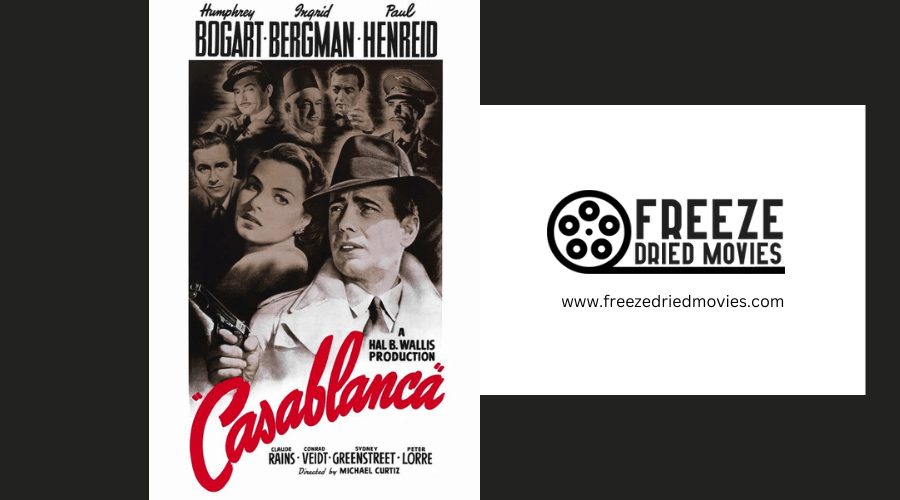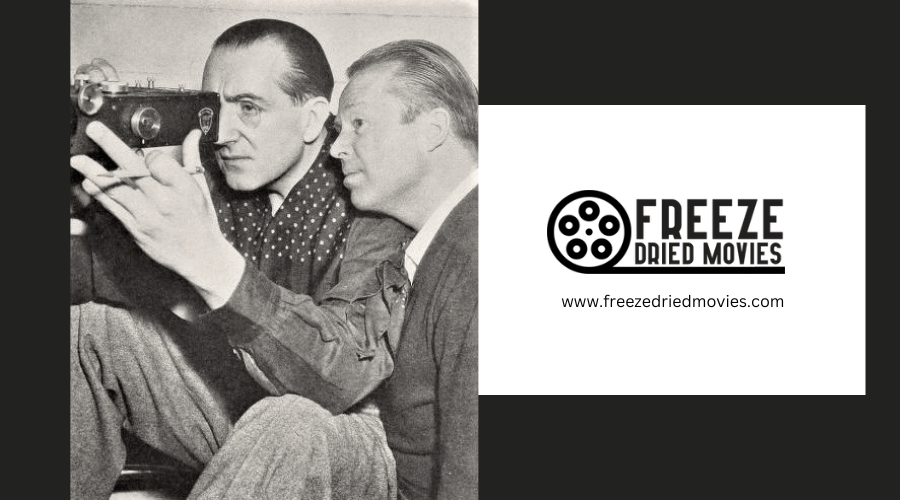What Are the Must-Watch Westerns of the 1940s?

If you're a Western genre enthusiast, the 1940s offer some unmissable classics. Dive into the tension and drama of a cattle drive in Howard Hawks' 'Red River,' featuring John Wayne.
Explore themes of military honor and conflict in John Ford's 'She Wore a Yellow Ribbon' and 'Fort Apache,' both starring Wayne.
Don't overlook 'My Darling Clementine,' a poignant portrayal of Wyatt Earp's infamous showdown at the O.K. Corral.
These films not only provide compelling narratives but also reflect the cultural values and challenges of their era, offering a deeper understanding of the genre's development.
Red River

In the classic 1940s Western 'Red River', directed by Howard Hawks, viewers are plunged into a dramatic cattle drive along the Chisholm Trail, led by the formidable John Wayne as Thomas Dunson and the compelling Montgomery Clift as Matthew Garth. This film masterfully depicts the perils and adversities of the trail, which not only test the physical endurance of its characters but also their moral and psychological boundaries.
John Wayne delivers a nuanced performance as Dunson, a man whose tough demeanor is as expansive as the plains themselves. Clift's portrayal of Garth offers a refreshing contrast, infusing youthful vigor and a questioning spirit that challenges Dunson's rigid principles. This conflict between generations highlights central themes of loyalty and authority, driving the narrative forward through tension and uncertainty.
'Red River' is more than a simple story of a cattle drive; it's an exploration of human resilience and the complexities of leadership and ambition under extreme circumstances. The film remains a pertinent and insightful examination of character and conflict, resonating with audiences as a trustworthy and enduring piece of cinematic history.
She Wore a Yellow Ribbon
In 'She Wore a Yellow Ribbon', John Wayne portrays a cavalry officer facing the dual challenges of impending retirement and a dangerous final mission. The film, directed by John Ford, delves into themes of aging, honor, and interpersonal relationships within a military context. Joanne Dru and John Agar also star, contributing to the narrative of camaraderie and individual struggle.
The film is distinguished not only by its narrative but also by its visual excellence, which earned it an Oscar for cinematography. The vivid portrayal of America's landscapes enhances the story's emotional depth, emphasizing the protagonist's last duty. The themes of honor and camaraderie are prominent, highlighted through the interactions among the characters, with Wayne's role exemplifying the conflict between duty and personal cost.
As the movie unfolds, viewers are drawn into the dynamics and relationships characteristic of military life. 'She Wore a Yellow Ribbon' is noteworthy for its authentic historical depiction and its engagement with timeless themes that remain pertinent today.
Fort Apache
'Fort Apache,' directed by John Ford and released in 1948, explores the intense conflicts of the Indian Wars in Arizona. The film stars John Wayne, Henry Fonda, and Shirley Temple and delves into the complex dynamics and strategies among U.S. Cavalry officers stationed in a contentious area. The narrative is driven by the tension between Henry Fonda's character, a rigid and imperious commander, and John Wayne's more diplomatic and understanding captain. Their contrasting approaches to leadership and conflict management are central to the film's plot, highlighting themes of authority and reconciliation.
Shirley Temple adds a layer of personal and familial drama to the military storyline, enriching the narrative with her performance. John Ford's direction ensures that the film not only portrays dramatic personal conflicts but also reflects the broader historical context, making the viewer aware of the challenging conditions during that era.
Critically acclaimed for its insightful commentary on leadership and ethical quandaries, 'Fort Apache' is recognized for its historical accuracy, compelling storytelling, and strong performances. It's noted for its significance in the Western genre and its thoughtful depiction of moral and leadership challenges. For those interested in a film that combines historical fidelity with profound narrative depth, 'Fort Apache' offers an engaging and educational experience.
The Treasure of the Sierra Madre
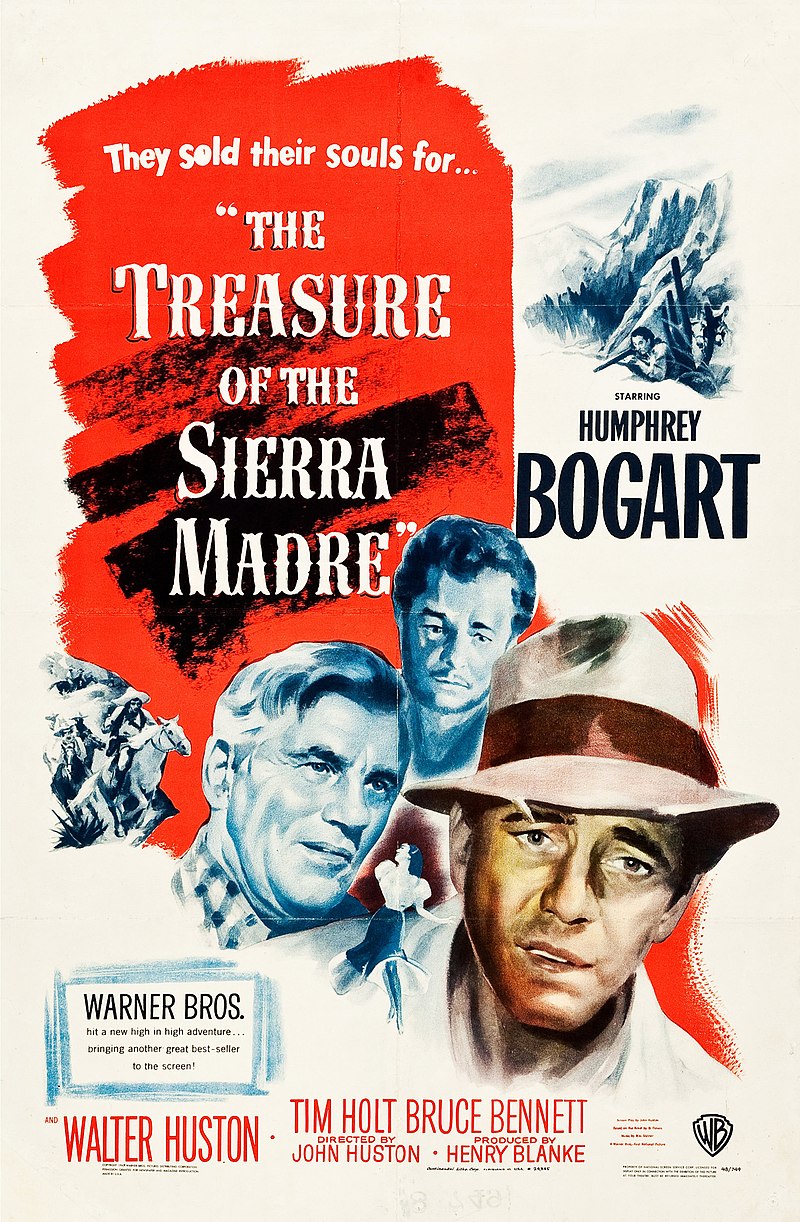
'The Treasure of the Sierra Madre,' directed by John Huston, masterfully explores the darker aspects of human nature, particularly greed and paranoia. The film features Humphrey Bogart, Walter Huston, and Tim Holt and is set in the challenging terrains of Mexico, where the pursuit of gold pushes characters to extreme behaviors.
The narrative delves into the psychological impacts of greed, as seen through Bogart's compelling portrayal of a man overwhelmed by his own desires. Walter Huston, who won an Academy Award for his performance, plays a wise but ultimately vulnerable character, illustrating the perilous effects of human weaknesses.
This classic film, rated 8.2 on IMDb, transcends the simple plot of treasure hunting to offer a profound commentary on the corruptive influence of wealth. It has earned multiple Academy Awards, affirming its significance in cinematic history.
'The Treasure of the Sierra Madre' is essential viewing, not only for its engaging story and performances but also for its critical examination of the lengths to which individuals will go for fortune.
My Darling Clementine

John Ford's 1946 Western, 'My Darling Clementine,' epitomizes the Old West, focusing on the famous gunfight at the O.K. Corral. Henry Fonda stars as Wyatt Earp, portraying the legendary figure with charisma and stoicism. The film is set against quintessential rugged landscapes, weaving a narrative of revenge and camaraderie.
Ford's directorial approach lends a poetic touch to the depiction of the Old West, establishing 'My Darling Clementine' as a seminal Western of the 1940s. The plot revolves around Earp's pursuit of justice after his brother's murder, incorporating themes of loyalty and integrity. Victor Mature delivers a nuanced performance as the ailing Doc Holliday, Earp's complex ally.
Linda Darnell plays Chihuahua, adding romance and intrigue and enhancing the plot with her dynamic presence. This blend of historical interpretation and personal drama positions the film as a landmark in American cinema.
'My Darling Clementine' is more than a film; it's an authentic representation of the Old West, combining gritty realism with iconic storytelling. This makes it essential viewing for Western genre aficionados.
The Ox-Bow Incident
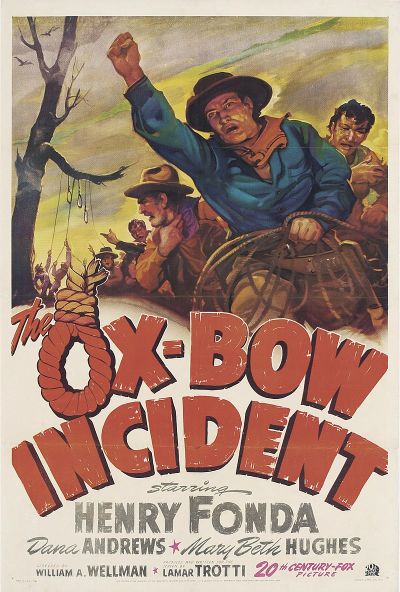
After the romantic portrayal of the Old West in 'My Darling Clementine,' 'The Ox-Bow Incident' presents a stark contrast, delving into the grim realities of frontier justice. This compelling drama, starring Henry Fonda, centers on the harsh consequences of vigilante justice in a small Western town. The film, based on Walter Van Tilburg Clark's novel, critically examines human nature and the pressures of societal norms.
The plot unfolds as a group of townspeople, driven by fear and suspicion, illegally take justice into their own hands. This leads to a profound exploration of collective conscience and the moral fallout of their actions.
Released in the 1940s, 'The Ox-Bow Incident' is renowned for its strong storytelling and authenticity. The black and white cinematography not only reflects the era's film style but also intensifies the sobering atmosphere, urging viewers to contemplate the severe impacts of rash justice. The film's narrative strength and well-developed characters make it an unforgettable Western that addresses important ethical questions.
Duel in the Sun
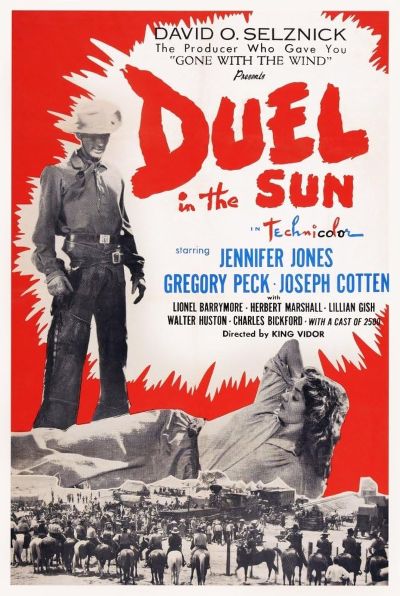
'Duel in the Sun,' a 1946 Western film, features a dramatic love triangle between two brothers and a fiery woman, portrayed by Jennifer Jones and Joseph Cotten. This film explores deep themes of love, power, and moral dilemmas, engaging viewers in both its intense character dynamics and broader narrative conflicts.
The antagonist in the film is a complex character struggling with both virtuous intentions and darker impulses. This internal conflict enhances the film's tension and depth, reflecting the broader chaos depicted in the story. 'Duel in the Sun' achieved significant commercial success, grossing over $20 million, which underscores its popularity and impact during the 1940s.
Here are some key details about 'Duel in the Sun':
| Aspect | Detail |
|---|---|
| Release Year | 1946 |
| Main Actors | Jennifer Jones, Joseph Cotten |
| Themes | Love triangle, passion, moral dilemmas |
| Commercial Success | Grossed $20.41 million |
For fans of Westerns seeking more than typical gunfights, 'Duel in the Sun' offers a profound exploration of the human spirit, making it an essential watch.
Yellow Sky
Have you ever delved into the captivating world of 'Yellow Sky,' a standout Western from 1948? Set against the stark and stunning backdrop of Death Valley National Monument, this film is a classic of its genre, blending a compelling narrative with remarkable visual storytelling. It holds an IMDb rating of 7.4, attesting to its enduring appeal and impact on viewers.
In 'Yellow Sky,' the production team constructed a detailed ghost town to serve as the film's central setting. This town isn't merely a backdrop but a character in its own right, reflecting the isolation and lawlessness central to the Western genre. The authenticity of this set contributes significantly to the film's immersive and gritty atmosphere.
The film masterfully explores themes of survival and morality, set against the expansive desert landscapes and the meticulously crafted ghost town. 'Yellow Sky' stands out for its effective portrayal of the challenges and spirit of the Old West. It's a cinematic journey well worth experiencing for anyone interested in this iconic era of film history.
The Outlaw
Exploring both controversy and innovation, 'The Outlaw,' directed by Howard Hughes in 1943, marked a pivotal moment in the Western film genre. This movie transcends the typical cowboy narrative by integrating bold storytelling with innovative technical approaches. Featuring Jane Russell and Jack Buetel, the film encountered significant censorship challenges due to the provocative depiction of Russell's character, which tested the limits of the film standards of that era.
Here's why 'The Outlaw' stands out:
- Provocative Portrayal: Jane Russell's character introduced a new level of sensuality to Western films, testing societal norms and the era's censorship regulations.
- Innovative Cinematography: Hughes' use of advanced lighting techniques and unique camera angles established new benchmarks in film aesthetics.
- Controversies: Its daring content sparked considerable debate, drawing attention from both the public and critics, which contributed to its iconic status.
- Unconventional Storytelling: 'The Outlaw' diverges from typical Westerns by focusing on character development and psychological depth rather than just gunfights.
Despite facing numerous hurdles, 'The Outlaw' emerged as a groundbreaking work that significantly influenced the evolution of its genre. If you're interested in a Western that offers depth beyond typical shootouts and saloon brawls, consider watching this 1943 classic.
Conclusion
Explore some of the definitive Westerns from the 1940s that have shaped the genre.
The intense character interactions in 'Red River,' the striking visuals of 'She Wore a Yellow Ribbon,' and the compelling authenticity of 'The Treasure of the Sierra Madre' exemplify the era's cinematic landscape.
These films not only offer a glimpse into the historical and cultural contexts of their time but also continue to influence the Western genre today.
Dive into these classics to fully appreciate the narratives, settings, and iconic characters that epitomize the spirit of the Old West.



